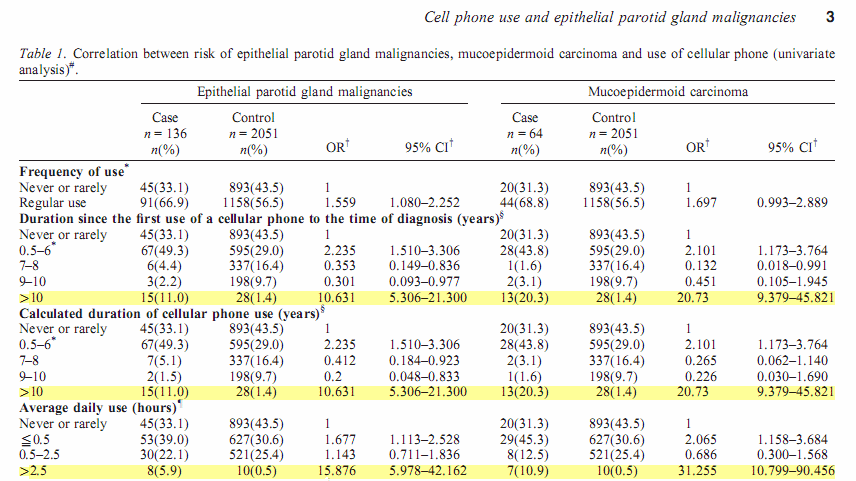Chinese Put Cancer of the Parotid Gland on Center Stage
Chinese researchers in Beijing are seeing some of the highest rates of cancer ever reported in any cell phone study. They have found that long-term, heavy users have rates of malignant parotid gland tumors that are seven to 13 times higher than might otherwise be expected.
The raw data —that is, before being adjusted for other possible risk factors like sex, age, income, smoking status and the like— point to cancer risks that are elevated 10-fold, 20-fold, and even 30-fold, depending on the type of tumor and how heavy cell phone use is defined (see table below). For instance, those who had used mobile phones for over ten years had more than ten times the rate of epithelial parotid gland malignancies, the dominant type of cancer of parotid gland. The risk rose to 20 times that of controls for mucoepidermoid carcinoma, the primary subtype of parotid gland cancer. Those who used a cell phone for more than two-and-a-half hours a day had a more than 15-to-30 fold elevated cancer risk. Previous studies have rarely pointed to a risk that is more than double or triple the expected rate.
These elevated risks, though based on a small number of cases —at most 15 in the highest exposure category— are statistically significant. Importantly, Y. Duan, Haizhong Zhang and R.F. Bu at the Chinese PLA General Hospital in Beijing see "general indications" of a dose-response relationship. The new paper was posted on the Web site of the Journal of Oral and Maxillofacial Surgery on April 6. Zhang is the corresponding author of the paper.

"There are so many young cases of parotid gland tumors in the [last] five years, yet [so few] in the last century," Zhang told Microwave News, "I want to find the reasons." Zhang is the director of the Department of Oral & Maxillofacial Surgery at the PLA General Hospital.
Parotid gland tumors are rare, with an incidence of 2.5-3 cases per 100,000 per year in Western countries, according to the National Cancer Institute (the rate in China is not known). Benign parotid gland tumors are much more common than malignant tumors. So far, no other group has been able to look at the risk for malignant parotid gland tumors in such detail. The Chinese researchers have 136 cases, enough to do a separate analysis for the 64 cases of the mucoepidermoid carcinoma subtype (these make up about 35% of all malignant tumors of the parotid gland). Fifteen of the cases had used a cell phone for more than 10 years; 13 of the 15 had mucoepidermoid carcinoma.
There were 747 million users of cell phones in China at the end of 2009, according to Zhang and colleagues.
In comparison, the Israeli Interphone team, which was the first to report a long-term risk of parotid gland tumors three years ago, had a total of 58 cases with malignant tumors and only one of these had used a mobile phone for at least ten years. The elevated risk seen by Siegal Sadetzki and her Israeli coworkers was based on an excess of benign tumors. Stefan Lönn and the Swedish Interphone team had 60 cases with this malignancy, and here again only one case with a ten-year use history. Two earlier studies were unable to look at the risk among long-term users.
Late last year, a group at Hebrew University reported sharp increase in the incidence of parotid gland tumors in Israel over the last 30 years. This observation lent support to Sadetzki's findings (see "Game Changer?").
The new Chinese paper comes on the eve of the International Agency for Research on Cancer's (IARC) review of the cancer risks associated with wireless radiation, which begins in Lyon, France, on May 24. The IARC review panel will most likely consider it as it was released before the April 24 cut off for new data.
A number of aspects of the Chinese paper do not fit current understanding of cell phone tumor risks. For instance, Zhang and colleagues did not see a significant association between the location of the tumor and the preferred side for using a cell phone (known as laterality). They acknowledge that this prevents them from reaching a "definitive conclusion about the effect of cellular phone usage."
A second anomaly is that rural residents had a lower risk than those in the city, the opposite of what Sadetzki reported. (Cell phones tend to operate at higher power levels in the countryside where towers are spaced further apart. This leads to higher radiation exposures and possibly higher tumor risks.) Zhang explains that this may be because rural residents in China tend to have lower incomes than urban residents and cannot afford cell phones. In addition, the Chinese team was unable to look at the possible different effects of digital and analog phones, because, they explain, "most regular users did not know their cellular phone type."
Zhang and colleagues conclude that they cannot exclude the possibility of distortions due to recall or selection bias. They suggest that "additional large-scale studies, especially those with a prospective design, be performed to reduce the sources of bias and to confirm the significance of the present results."
